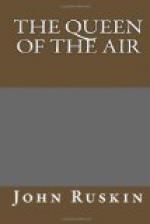86. Now, it is easy to conceive that flowers of this kind, growing in close clusters, may, in process of time, have extended their outside petals rather than the interior ones (as the outer flowers of the clusters of many umbellifers actually do), and thus elongated and variously distorted forms have established themselves; then if the stalk is attached to the side instead of the base of the tube, its base becomes a spur, and thus all the grotesque forms of the mints, violets, and larkspurs, gradually might be composed. But, however this may be, there is one great tribe of plants separate from the rest, and of which the influence seems shed upon the rest, in different degrees; and these would give the impression, not so much of having been developed by change, as of being stamped with a character of their own, more or less serpentine or dragon-like. And I think you will find it convenient to call these generally Draconidae; disregarding their present ugly botanical name which I do not care even to write once—you may take for their principal types the foxglove, snapdragon, and calceolaria; and you will find they all agree in a tendency to decorate themselves by spots, and with bosses or swollen places in their leaves, as if they had been touched by poison. The spot of the foxglove is especially strange, because it draws the color out of the tissue all around it, as if it had been stung, and as if the central color was really an inflamed spot, with paleness round. Then also they carry to its extreme the decoration by bulging or pouting out the petal,—often beautifully used by other flowers in a minor degree, like the beating out of bosses in hollow silver, as in the kalmia, beaten out apparently in each petal by the stamens instead of a hammer; or the borage, pouting towards; but the snapdragons and calceolarias carry it to its extreme.
87. Then the spirit of these Draconidae seems to pass more or less into other flowers, whose forms are properly pure vases; but it affects some of them slightly, others not at all. It never strongly affects the heaths; never once the roses; but it enters like an evil spirit into the buttercup, and turns it into a larkspur, with a black, spotted, grotesque centre, and a strange, broken blue, gorgeous and intense, yet impure, glittering on the surface as if it were strewn with broken glass, and stained or darkening irregularly into red. And then at last the serpent charm changes the ranunculus into monkshood, and makes it poisonous. It enters into the forget-me-not, and the star of heavenly turquoise is corrupted into the viper’s bugloss, darkened with the same strange red as the larkspur, and fretted into a fringe of thorn; it enters, together with a strange insect-spirit, into the asphodels, and (though with a greater interval between the groups) they change to spotted orchideae; it touches the poppy, it becomes a fumaria; the iris, and it pouts into a gladiolus; the lily, and it chequers




